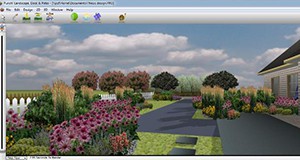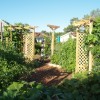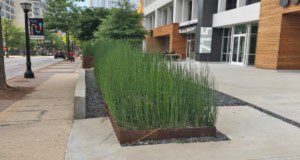Ornamental grasses create interest and excitement in the landscape with their unique characteristics. The availability of a large number of species and cultivars makes these plants very versatile, with many potential uses in the landscape. This publication outlines many of the considerations for the proper selection and use of ornamental grasses. The information and tables should assist the first-time gardener as well as the experienced landscaper in the selection and use of ornamental grasses in Florida. This 9-page major revision was written by Mack Thetford and Mary Salinas and published by the UF/IFAS Environmental Horticulture Department.
https://edis.ifas.ufl.edu/ep233
Tag: Landscape Design
Landscape Design Software: Evaluation and Recommendations for Homeowners

Homeowners who are computer literate and want to improve their landscapes often consider purchasing software so that they can create the design themselves and save money. To help you select a program from the dozens that are available, each with different levels of cost and difficulty, UF/IFAS scientists tested seven popular do-it-yourself programs, compared them to a professional landscape design software program, and rated them for quality of features and ease-of-use. This 9-page fact sheet written by Gail Hansen, Smith Watkins, and Sydney Park Brown and published by the Department of Environmental Horticulture will help you estimate costs, ensure compatibility with your Windows-based or Apple-based operating system, and compare reviews from consumer websites so that you can choose the software that best fits your needs.
edis.ifas.ufl.edu/ep526
Landscape Design with Edibles (ENH1214/EP475)
 Although design basics for edible ornamental landscapes are essentially the same as strictly ornamental landscapes, a few details ensure the success of the edible landscape. Gardens with plants that change considerably with the seasons rely more on an organized yet interesting layout, appealing support structures, functional pathways, and colorful containers and planters to provide interest and beauty when the plants are not taking center stage. There are twelve important ideas to consider when creating a successful edible ornamental garden. This 4-page fact sheet was written by Gail Hansen, and published by the UF Department of Environmental Horticulture, May 2013.
Although design basics for edible ornamental landscapes are essentially the same as strictly ornamental landscapes, a few details ensure the success of the edible landscape. Gardens with plants that change considerably with the seasons rely more on an organized yet interesting layout, appealing support structures, functional pathways, and colorful containers and planters to provide interest and beauty when the plants are not taking center stage. There are twelve important ideas to consider when creating a successful edible ornamental garden. This 4-page fact sheet was written by Gail Hansen, and published by the UF Department of Environmental Horticulture, May 2013.
http://edis.ifas.ufl.edu/ep475
Landscape Design: Drawing a Planting Plan (ENH1195/EP456)
 Selecting and placing plants in the landscape is the art and science of arranging plant material to make a healthy, functional, and beautiful yard. The mix of science and art is expressed in the guiding principle of “right plant, right place,” meaning to select plants that can thrive in the growing conditions of the site and locating them for both visual appeal and health. Selecting and arranging plants are the last steps in the overall design process after the site analysis is complete and the activity areas located and designed.Developing the planting plan is a sequential process, but it is important to remember that the process is not completely linear; sometimes decisions about plant material require reworking previous steps in the sequence and making adjustments to the plan. This 10-page fact sheet was written by Gail Hansen, and published by the UF Department of Environmental Horticulture, January 2012.
Selecting and placing plants in the landscape is the art and science of arranging plant material to make a healthy, functional, and beautiful yard. The mix of science and art is expressed in the guiding principle of “right plant, right place,” meaning to select plants that can thrive in the growing conditions of the site and locating them for both visual appeal and health. Selecting and arranging plants are the last steps in the overall design process after the site analysis is complete and the activity areas located and designed.Developing the planting plan is a sequential process, but it is important to remember that the process is not completely linear; sometimes decisions about plant material require reworking previous steps in the sequence and making adjustments to the plan. This 10-page fact sheet was written by Gail Hansen, and published by the UF Department of Environmental Horticulture, January 2012.
http://edis.ifas.ufl.edu/ep456
Twenty-Two Ideas for a Low-Care, Low-Cost Landscape (ENH1181/EP442)
Many homeowners desire a beautiful landscape but are often discouraged by the lack of time and money needed to create and care for the garden of their dreams. A pleasing, low-care, low-cost landscape is possible, however, with careful planning, appropriate plant choices, and thoughtful design. This 11-page fact sheet was written by Gail Hansen, and published by the UF Department of Environmental Horticulture, April 2011.
http://edis.ifas.ufl.edu/ep442
ENH1172/EP433 Landscape Design: Aesthetic Characteristics of Plants
ENH1172, an 8-page illustrated fact sheet by Gail Hansen and Erin Alvarez, discusses form, texture, size and color of landscape plants and how to choose plant combinations based on these qualities to create a composition of plant material. Includes references. Published by the UF Department of Environmental Horticulture, September 2010.
http://edis.ifas.ufl.edu/ep433
ENH1169/EP430 Landscape Design: Finding Inspiration for a Design Theme
ENH1169, a 4-page illustrated fact sheet by Gail Hansen and Erin Alvarez, suggests types of design themes, sources of inspiration, and how to incorporate a theme into a landscape design. Includes references. Published by the UF Department of Environmental Horticulture, July 2010.
http://edis.ifas.ufl.edu/ep430
CIR536/MG086 Basic Principles of Landscape Design
Revised! Circular 536, a 12-page illustrated circular by Gail Hansen, explains the design process that landscape designers use, that systematically considers all aspects of the land, the environment, the growing plants, and the needs of the user to ensure a visually pleasing, functional, and ecologically healthy design. Published by the UF Department of Environmental Horticulture, July 2010.
http://edis.ifas.ufl.edu/mg086
ENH1165/EP426 Landscape Design: Analyzing Site Conditions
ENH1165, a 4-page illustrated fact sheet by Gail Hansen and Erin Alvarez, takes homeowners through the process of developing an inventory and analysis of their yards to determine action items toward achieving the desired results in their landscape design. Includes references. Published by the UF Department of Environmental Horticulture, June 2010.
http://edis.ifas.ufl.edu/ep426
ENH1163/EP424 Landscape Elements for a Florida-Friendly Yard
ENH1163, a 5-page illustrated fact sheet by Gail Hansen, lists common elements of well designed Florida yards, grouped into three categories: environmental health, function, and design. Includes references. Published by the UF Department of Environmental Horticulture, March 2010.
http://edis.ifas.ufl.edu/ep424
ENH1110/EP374 Design Strategies for a Sustainable Home Landscape
ENH-1110, a 5-page fact sheet by Gail Hansen de Chapman, describes strategies for landscape design that is Florida-friendly without compromising aesthetics. Includes references. Published by the UF Department of Environmental Horticulture, January 2009.
http://edis.ifas.ufl.edu/EP374
